We've added a Porsche Panamera to the fleet
Yes, we're running a £160,000 Porsche Panamera for a long-term test...
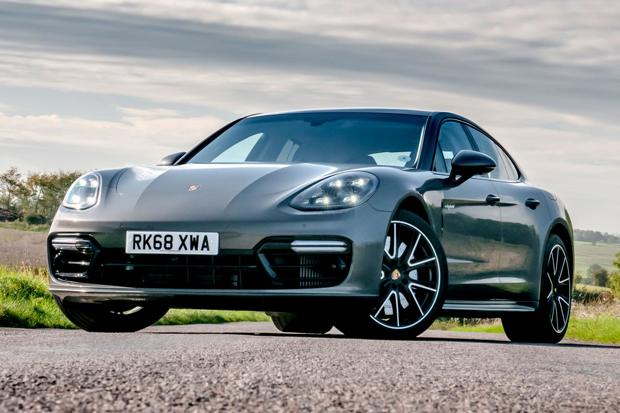
Date: 23 September 2019 | Current mileage: 12,387 miles | Claimed fuel economy: 74.0mpg | Actual fuel economy: 22.6mpg
You’ve got a theoretical £170,000 budget to buy a new car. Gone are the ideas of a Skoda Karoq or maybe a sensible Honda Jazz - you want the ultimate do-it-all car. A car that’s going to impress your neighbours, one that’s going to be big enough for the whole family and, on those rare occasions you get time to yourself, is fun to drive.
Enter the Porsche Panamera. Now, before you start commenting that we’ve lost our mind entirely and no longer represent the real-world car buyer, may we point out some more down-to-earth alternatives on our fleet. There’s the Peugeot Rifter, for example, or our Vauxhall Crossland X. David’s spending time with a Toyota Corolla while Mark’s running a Volkswagen T-Roc.
But yes, if you’re still reading this, I’m going to be getting to know the Porsche Panamera. A Porsche Panamera Turbo S E-Hybrid to be exact. It’s loaded with options - while the standard car is just £137,000, this one’s nudging on £160,000 thanks to extras like its SportDesign Package (£3741), 21-inch Exclusive Design wheels (£1335), Porsche InnoDrive with adaptive cruise control (£2438) and rear-seat entertainment (£2349). We'll come to what all that means in another update.
It's also a car that's due to be retired from Porsche's press car fleet, so it's not led an easy life so far. It's covered around 12,000 miles in the year since it's been registered, and they won't have been easy miles. So this could be an interesting test of reliability, too...
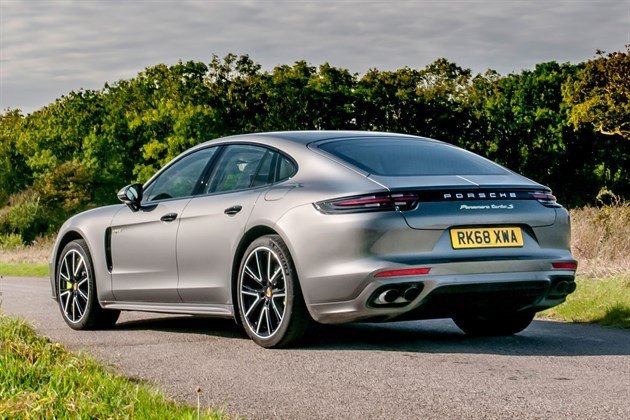
Further stats guaranteed to make you gasp (maybe), include the official fuel economy figures of more than 74.0mpg and CO2 emissions of just 74g/km, while 680PS from its V8 hybrid powertrain means it'll complete 0-62mph in 3.4 seconds. Yes, they're almost difficult to believe, and come down to the fact that the Turbo S E-Hybrid is, in fact, a plug-in hybrid.
That means you can plug it in at home, run it off electricity for some miles (in the region of 22, officially), and revel in the fact that you're greener than a diesel Golf.
I’m going to be running it the same as all other long-termers we run at HonestJohn.co.uk. I’m not going to be lapping Silverstone in it or heading across to Germany for a run on the autobahn (although a pre-Brexit European weekend away might be on the cards).
The most exciting thing it’s likely to encounter under my custodianship is a lunch run to a Tesco that previously claimed to be the biggest in the country. It's in Peterborough (and has since been usurped by a store in Manchester). Keep an eye on my updates to see how we get on...
Panamera completes a marathon sprint
Planning on running a marathon? Consider buying a Porsche...
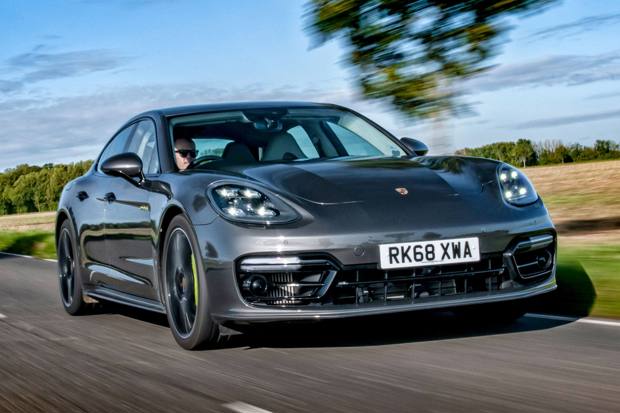
Date: 30 September 2019 | Current mileage: 12,783 miles | Claimed fuel economy: 74.0mpg | Actual fuel economy: 21.9mpg
I foolishly decided it’d be fun to take part in Northampton Half Marathon. It was one of those ideas that, at the start of summer and several months away, seemed like a brilliant plan. And then, before I knew it, race weekend arrived - amidst severe weather warnings and not enough training on my part.
What's that got to do with our Panamera? Well, it involved a 6am start, and it turns out that 6am on a Sunday morning is a good time for driving a Porsche. There’s little traffic on the road, so it’s possible to stretch its legs slightly, and overtaking opportunities open up at places that would normally be far too busy mid-week.
That’s especially true in the Panamera e-Hybrid Turbo S, which has an astonishing ability to make progress. I’m not talking about speeding for the sake of it or driving recklessly, I’m talking about spending the shortest amount of time on the wrong side of the road during overtaking.
During that hour-long drive from my home in Stamford to Northampton, I really got to appreciate the Panamera for the first time since I took delivery. I knew it was a totally capable long-distance cruiser, but it can also be a lot of fun.
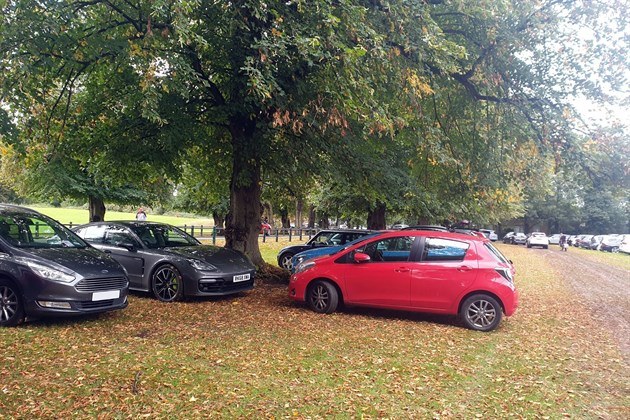
The heavens opened during the run. Fine for me, as temperatures were quite warm, but I was a little worried that I’d left the Panamera parked in a field. That was the least of my issues, as it transpired. I returned to the car to find that someone had helpfully parked a Toyota Yaris right in front of it.
Incidentally, the last time I got blocked in like this was when I was driving a Porsche 911. I was in France, and a French van driver decided the best car to park in front of in a hotel car park overnight was a red 911. Maybe it's a Porsche thing?
Anyway, the Panamera’s generous helping of cameras (as part of the £1062 ParkAssist including Surround View), meant I could just about squeeze out. It’s a wide car - nearly 2.0m wide, in fact - but the camera and sensor overload is very useful when you get blocked in by a Yaris.
Once out, the Panamera’s four-wheel-drive system meant it coped very well with the muddy car park. The closest I came to an issue was when two weary runners stepped out in front of me, not hearing the car. It was in e-mode, running entirely under electric power...
The thing I hate most about the Porsche Panamera
If there was one thing we could change about the Porsche Panamera, this would be it...
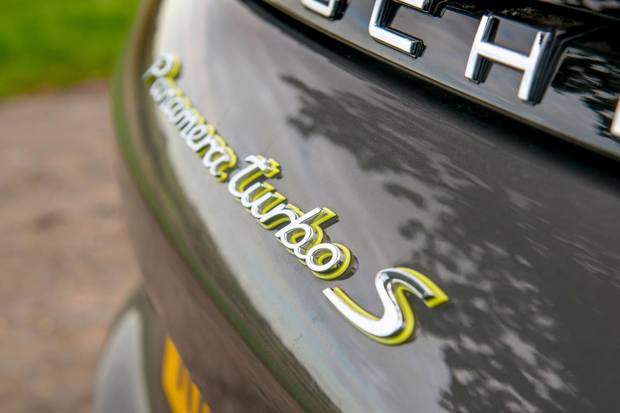
Date: 7 October 2019 | Current mileage: 13,195 miles | Claimed fuel economy: 74.0mpg | Actual fuel economy: 23.0mpg
There's one thing that bugs me about the Porsche Panamera. It's the same thing that bugs me about every new Porsche currently on sale, as well as those from other premium brands including BMW. It's the lack of Android Auto.
If you're not familiar, Android Auto (and Apple's version, CarPlay), essentially mirrors certain functions from your phone on the car's media display in the centre of the dashboard. I'm a huge fan. It lets me use navigation apps such as Google Maps and Waze - which tend to work better than built-in navs - as well as entertainment functions such as BBC Sounds, Spotify and podcast apps.
Manufacturers of budget city cars realise that offering Apple CarPlay and Android Auto is a way of providing good infotainment without having to go to the expense of developing complex systems themselves, while also appealing to the millennials who tend to buy these sort of cars. That's why both Apple CarPlay and Android Auto are free on cars like the Kia Picanto and Toyota Aygo.
Some premium manufacturers realise they can make money out of our desire to access Spotify playlists on the move, so they charge extra for them. Despite being the first manufacturer to offer CarPlay in a production car, Ferrari charges an outrageous £2400 to spec it on a Portofino. I guess, the argument is, if you can afford a Ferrari Portofino, you won't be tight about an extra couple of grand to use your phone on the move...
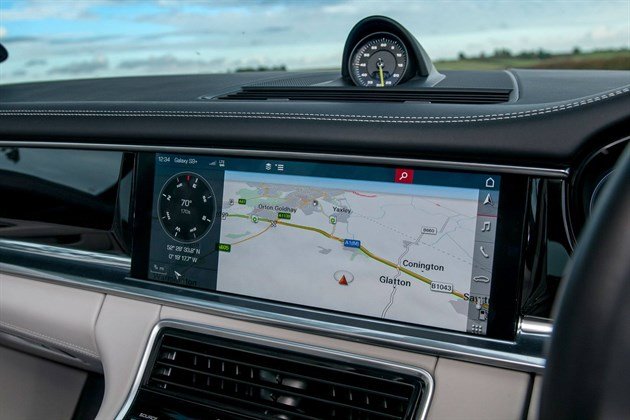
Porsche doesn't go that far. Apple CarPlay is standard on the Panamera, but there's no Android Auto available at all. Reports have previously suggested that's because Google demands information like vehicle speed, throttle position, fluid temperatures, and engine revs in return for Android Auto - and Porsche isn't keen to provide that sort of data.
Personally, I'd be happy for Google to see that I'm sitting at 5mph in stop-start traffic on the M25 in exchange for reading out WhatsApp messages to me, but I kind of see why Porsche is reluctant.
I suspect there's also an element that Porsche thinks its systems are better. It's spent all this money on a - admittedly very impressive - infotainment system, why would you want to bypass that using a third-party system?
It's also got its Porsche Connect app, which allows you to access some of your car's features remotely and use streaming services like Napster (remember that?) on the move. It's so fiddly that I've not managed to set it up, though, and going by the pages and pages of one-star reviews in the Google Play Store, I'm not the only one who'd prefer Android Auto.
Does the Porsche Taycan render the Panamera redundant?
It's battle of the plug-in hybrid versus electric as we pitch the Panamera against the new Porsche Taycan.
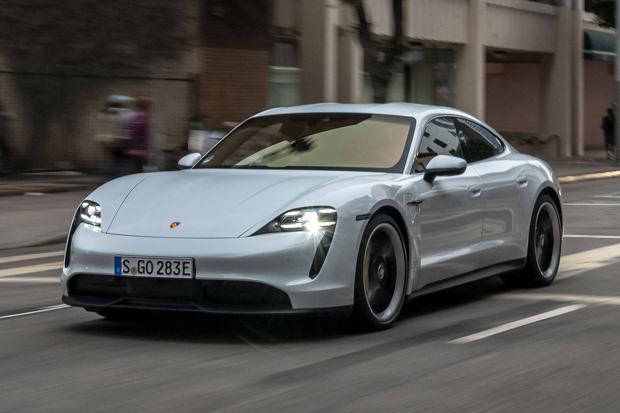
Date: 21 October 2019 | Current mileage: 13,636 miles | Claimed fuel economy: 74.0mpg | Actual fuel economy: 21.8mpg
It's easy to see the appeal of our Porsche Panamera. It's a big, wafty Porsche with electrified gubbins to prove you're doing your bit for the environment, as well as a 4.0-litre V8 engine for those times when you want to enjoy yourself.
But it's got a new rival... and it's an in-house competitor, the Porsche Taycan. While the Panamera (in e-Hybrid form) is a plug-in hybrid, the Taycan does away with the combustion engine and is powered solely by electricity. In top-spec Turbo S form it starts at around £139,000, boasts 761PS and can cover 0-62mph in 2.8 seconds.
That means it's quicker than the Panamera (which has a combined output of 680PS and reaches 62mph in 3.4 seconds), and roughly the same price (the Panamera Turbo S E-Hybrid starts at £140,132)
Of course, the advantage of the Panamera is that you can drive long distances in it with only short stops necessary to chuck some petrol in its 80-litre fuel tank.
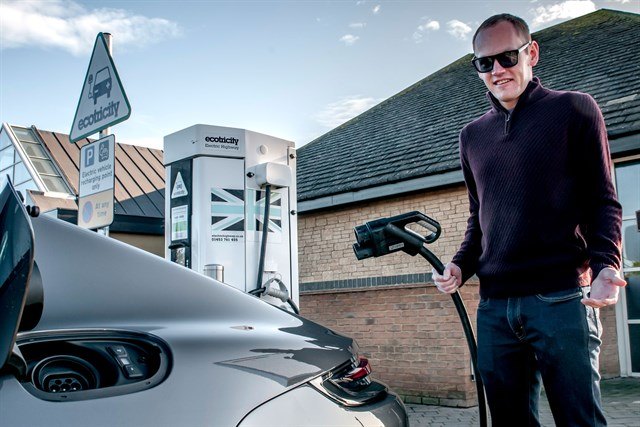
The Taycan's limited to around 250 miles between charges but it can charge at a rate of 270kW, meaning it can charge from 5 to 80 per cent capacity in around 22.5 minutes - subject to you finding a good enough public charger which, for the time being, is more difficult than it sounds.
To get the best out of the Panamera, you'll need to charge it regularly too. Officially, once charged, it'll cover 31 miles under electric power - meaning you could, in theory, bimble to the shops under electric power only. Of course, that's only if you resist the temptation to make the most of its performance - and if you do, you'll find the electric range drops much quicker.
While plug-in hybrid cars appeal to a different buyer than strict electric vehicles, there's sure to be some overlap between the Panamera and Taycan. The newer Taycan might do without a 4.0-litre V8 engine - which will upset ardent petrolheads - but it's also extremely quick and can travel far enough between charges to make it genuinely useable.
I know where my money would go, and it's not on our Panamera...
Why the Panamera is a truly great grand tourer
We take the Porsche Panamera on a European road trip.
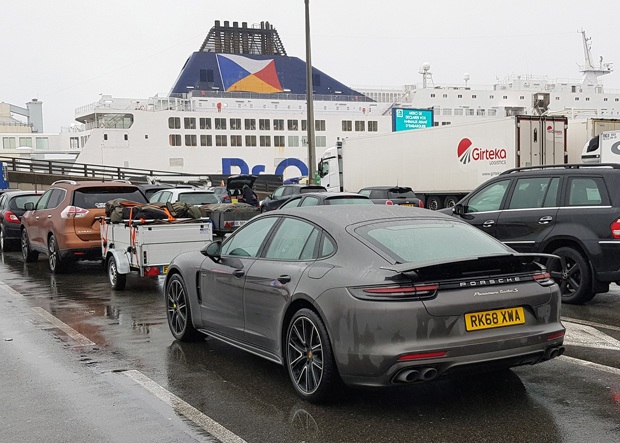
Date: 4 November 2019 | Current mileage: 14,306 miles | Claimed fuel economy: 74.0mpg | Actual fuel economy: 28.0mpg
"Ah, what a lovely Por-shaa" said the French customs official, as he waved me and the Panamera into a narrow holding bay at the Port of Calais. He'd clocked the car as I collected my boarding pass at the drive-through ticket office, and now he was waving me into a metal shed where three other cars were being unloaded and inspected by custom officials wearing bright yellow hi-vis vests.
Did he want to ask me where I'd been? Inspect the Panamera for contraband? Count how many cheeses I'd wedged into the boot space? Nope, he simply wanted a closer look at my monstrously fast Porsche. “Very nice. Too expensive for me, but I like it," he remarked, before making a token glance in the rear window and then waving me off with a smile. Clearly £160k Porsches do not require a closer inspection.
This Anglo-French customs experience marked the end of my three-day-trip in northern France and Belgium; I'd decided to test the Panamera's grand touring credentials by taking it Bruges to visit some friends. Over the three-day-trip I clocked up over 600 miles. And the Panamera had completed the job admirably, even if the lack of EV charging stations on my route in Belgium had resulted in a bank draining 28mpg.
That said, I think it's fair to assume that few Turbo S E-Hybrid buyers will care too much about fuel economy. After all, who spends £160k on a 680PS hyper car, if you worry about the cost of petrol? And for what this car lacks in efficiency, it more than makes up for in fun. Serious laugh out loud fun. The sort that makes your face ache because you’re smiling so much.

As a grand tourer, the Panamera is one of the very best. The large and luxurious cabin will waft four adults along in limo-like comfort, while the selectable driving modes - operated via a round dial at the bottom of the steering wheel - makes it easy to wind up or wind down the noise and performance.
That said, even in 'normal mode', the Turbo S E-Hybrid is a truly exhilarating car to drive. It also does a remarkable job of hiding its 2.4 tonne kerb weight. Indeed, the steering is nicely weighted, the V8 is packed with torque and the four-wheel drive system provides a vice-like grip of the road.
On my outward drive to Bruges, I turned off the N9 motorway two junctions early, so I could sample Belgium's twisty B roads and get a feel for the Panamera's supercar rivalling power - and it didn't disappoint, with the V8 and electronic motor developing a whopping 770Nm of torque. This means even a moderate amount of pedal push will pin you backwards as the tyres bite into the road and slingshot you down the road. My return leg took in the coastal route of the N34, which returned equal measures of seaside slingshot road fun.
Criticisms? Well, there's no blind spot assist, which is baffling when you consider the price of this car and the fact it's over five metres in length. The hybrid system is also prone to the odd wobbly moment at low speeds, with a slight judder being felt through the powertrain as the engine takes over from the battery. But these are relatively minute moans when compared to the general outstanding brilliance of the Turbo S E-Hybrid. It's our new favourite thing.
Goodbye Porsche Panamera
The Panamera has returned to Porsche. Sad face.

Date: 11 November 2019 | Current mileage: 14,965 miles | Claimed fuel economy: 74.0mpg | Actual fuel economy: 24.3mpg
It seems kind of appropriate that the fastest car we've ever had on long-term test is also the fastest to depart. Yes, after just over a month, the Panamera Turbo S E-Hybrid has gone back to Porsche.
During that time, we've ran marathons with it, taken it on a pre-Brexit European road trip and pitched it against the new Porsche Taycan. And it's done it all brilliantly.
It was no surprise that the Panamera was quick enough to surprise everyone who drove it. Its interior was wonderful, of course, and it felt entirely worth its £170,000 price tag.
But we were more interested in what it was like to live with day-to-day. And we haven't come away without a few gripes. For a start, the Android-using members of the team were frustrated to find the Panamera lacked Android Auto, despite Apple CarPlay being standard. We've driven budget city cars with this fitted as standard - why isn't it available on the Panamera?

There's also the fuel economy. We have to confess, we didn't charge the Panamera as much as we ought to have done. Faffing around with cables for a few miles of electric miles just never seemed worth the effort. Still, we saw around 28mpg on a long run which, while a long way off its official 74mpg figure, isn't all that bad for a car with this performance on offer.
We also think the new Taycan will render the plug-in Panamera irrelevant for many people. The electric Porsche is faster than the Panamera, can charge as quick as you can down a coffee, and is good for 250 miles. Which is enough for the majority of buyers.
All this aside, we've come away very impressed with the Panamera. It's an easy car to drive every day in all conditions and, despite our car about to retire from its difficult life as a press demonstrator, there were no reliability concerns at all. Not even a single squeak or sign of a hard life.
It's also a practical choice. You can fit four adults in the Panamera in comfort, and there's plenty of luggage space for a week or two in the Alps. There we are, genuine consumer advice.

